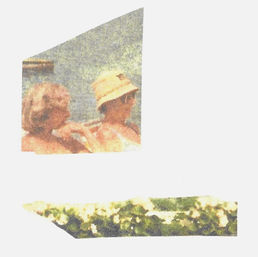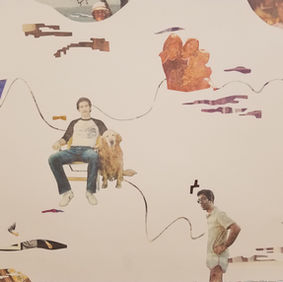Remedy for Memory -Solo show (2020)
Xerox transfer, inkjet prints on paper
308 prints, 4" x 4" each
2020
I explore the ideas of memory, absence, mortality, and the passage of time in my prints. Our memories are naturally inconsistent and fleeting; it’s impossible to remember everything in our lives clearly, especially as we age. Important memories move from short-term memory to long-term memory. And everytime we recall memories from our long-term memory, in particular, some of the information either gets lost in the retrieval or our brains fill in small gaps with other memories, resulting in a slightly different and ever-changing “false” memory. Through those countless retrievals, our memories of those precious loses its “truth” as our brains start to fill in the blanks with other memories or narratives that aren’t consistent with what really happened.
My artistic process starts with identifying my sources; I pull my inspiration from family photo albums, dating back to the 1950’s and 60’s. I made photocopies of the pictures and physically cut out pieces of the image to strip it of its details, which speaks to the absence, the mortality of people/places, and the fleetingness of memories. I end my process by transferring the scraps onto a new piece of paper, using lacquer thinner, a photo transfer chemical.
In consequence of those countless retrievals, our memories of those precious moments lose its “truth” as our brains start to fill in the blanks with other memories or narratives that aren’t consistent with what really happened. Through printmaking, my prints become immensely abstracted from their original start as a photograph, which shows the inconsistent and ephemeral side of our memories.

Displayed at WMU Kerr Gallery
Remnants (2019)
Remnants
86 xerox transfer on 4" x 4" stonehenge paper
2019
For this project, I was interested in taking scraps of photo copied family pictures I've been saving for about 2 years, and transfer them using a photo transfer chemical onto 4" x 4" pieces of paper. Here, they are like quick flickers or "blurbs" of faint memories that you remember for just a second, and then they fade away. To me, the transfers are the byproducts of the original memories depicted that I just couldn't bring myself to throw away because I was still emotionally attached to them.

Displayed at WMU Frostic School of Art
Episodic Memory Scramble (2019)
Episodic Memory Scramble
Xerox transfer, inkjet prints on paper
22" x 30" each
ep·i·sod·ic mem·o·ry
nounPSYCHOLOGY
-
a type of long-term memory that involves conscious recollection of previous experiences together with their context in terms of time, place, associated emotions, etc.
"those results suggest that participants were using episodic memory to recall the presented words in all conditions"-
a conscious memory of a previous experience.
"the hippocampus is critically involved in forming episodic memories"
-
Important memories move from short-term memory to long-term memory. Everytime we recall memories from our long-term memory, in particular, some of the information either gets lost in the retrieval or our brains fill in small gaps with other memories, resulting in a slightly different and ever changing “false” memory. For this project, I focused on the physical absence of my family’s cottage that was where 60 years worth of important moments and memories were housed. Since the cottage itself is no longer standing, my family and I are left with only the memories we have there, but accessing those memories is getting more difficult as we all age. These prints show the deterioration of memories that occurs when we try to retrieve them from our long-term memory, and the gaps in memory that are either filled with false information or just left blank.



































